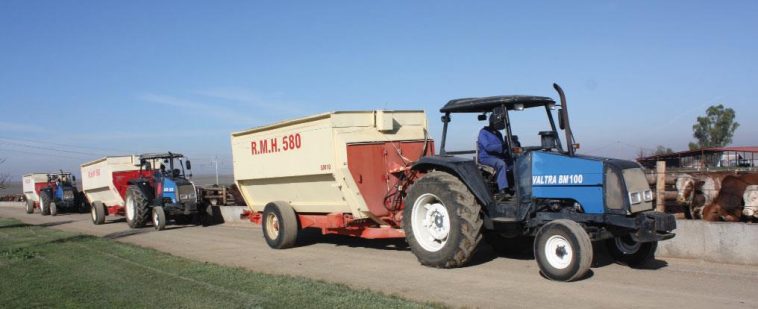When Edwin Claassen made the wise decision to buy a fleet of Valtra tractors for the expanding Midland Group in 2003, he sowed the seeds from which he still reaps a rich harvest today, sixteen years later. Amongst the acquired tractors were several BM100’s and BM 120’s.
With ProAgri’s visit to Gysberthoek Feedlot near Vereeniging, we had to nicely request the Valtra BM 100 drivers to desist from working for a little while so that we could take photographs.
“The tractors work every day, may it be an ordinary day, a public holiday, Christmas or New Year’s Day,” says Hans Pieters, Feedlot Manager at Gysberthoek.
With 15 000 and 16 000 heads of cattle to feed every day, the Valtra tractors have an important, yet demanding job. Their main function is to draw the feed mixers that mix the feed rations for the cattle, and to deliver the feed into the feeding troughs stretching over many kilometers.
Every day the wheels, engine and PTO of every BM100 and BM120 keep on turning for hours on end. Hans says he has tried to calculate the hours that these tractors have worked, because the hour counters have been replaced, but he stopped counting at 35 000 hours.
If you convert this to kilometers, it means far more than a million kilometers per tractor. Should they take the road upwards, they would have been well past the moon on their way to Mars by now. However, their work down here on earth is not done yet.

Hans says they never had to open or overhaul an engine, so he believes there are still many hours of work left in every one of these tractors.
“You will never find a Valtra engine that smokes,” he claims. Oil leaks are also very rare. Some parts must be replaced due to wear, but he diligently sees to it that the tractors are properly maintained.
His motto is: “Care for your machine and your machine will care for you.” Every tractor has a designated operator who shares the responsibility. Every tractor also must be washed every day to disclose any possible oil leaks, as oil leaks usually indicate problems.
“On Fridays, we meet to discuss any possible problems with machinery on the farm, because a problem rectified in time is a small problem,” Hans says.

Another important advantage of Valtra tractors is their fuel consumption. Even the Valtra’s with the older technology use very little fuel. Hans attributes this to the excellent design of the Finish tractors, and the use of thin air compensators.
Valtra was the first tractor manufacturer to employ turbo chargers. The Valtra factory in Brazil still manufactures the BM100 (73,5 kW and 77 kW, but the new ones appear more modish with rounder lines. They are not available in South Africa at present, but there are many other models to choose from.
Hans says he is so impressed with Valtra that he recently convinced his cousin to buy a Valtra TwinTrac that makes bean harvesting a sheer pleasure with its turn-around seat.
The Midlands Group uses these tractors in the feedlots, and also in the fields to cultivate grain for silage and grain marketing – and it is obvious that they and Valtrac, the suppliers of Valtra tractors in South Africa, are going to remain partners for a long time.

To see the whole range of Valtra tractors available in South Africa, visit www.valtrac.co.za, or call at Valtrac’s impressive display of top technology at NAMPO. You may also contact Attie de Villiers on 083-261-9863, 056-817-7308 or at attiedev@valtrac.co.za for more information.

